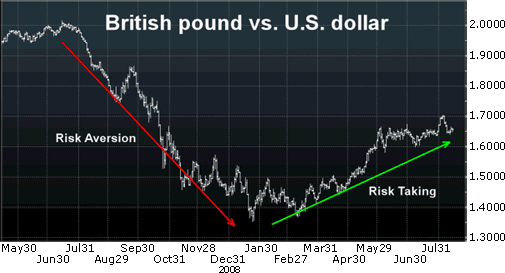
You can see from the chart below of sterling against the U.S. dollar. The pound fell sharply (U.S. dollar rose) in risk aversion as investors fled to the dollar. Now the pound is higher in riding a wave of increasing risk appetite.

Within this environment of risk, the relationship between risk and financial markets has been very clear: When risk appetite is high ... stocks, commodities, interest rates and all currencies (except the U.S. dollar) rally. When fear creeps back, the benefits of the dollar, the benefits of U.S. Treasury market and almost everything else fails.
So when the jobs report last week showed a lower unemployment and fewer job losses, the dollar should have been a great success. But it did not. Instead, they met!
Well, one day does not a trend.
And after the market digested a statement from the Fed cautiously positive this week on the economy, the activity resulting in the coins spoke clearly: For the moment, is still risk appetite.
I, however, expect a shift in market focus to be held in the short term, to accommodate this growing sense of recovery. I think that global capital will begin to shift towards economies that are relative outperformers. And for 2009 and 2010 consensus estimates of U.S. outperforming other major developed market economies.
Last month the IMF lowered its forecast in the euro area, hoping that the economy of the region to fall from 4.8 percent in 2009. And for 2010, while all other economies are expected to grow, the euro area is expected to fall further.
So, Germany and France, the two largest euro zone economies, shocked the market this week by the announcement of real growth for the second quarter!
Besides this, central banks are to improve economic forecasts for 2009, when it was thought to be a complete disaster. And 2010 was promoted further.
In fact, the European Central Bank has now revised its expectations for 2009 and 2010: Waiting for only a mild contraction in 2009 and growth in 2010.
However, in a period less bad is the new product, and economies are no longer in free fall and are now showing signs of improvement, the story is about the sustainability of the recovery, not just data points.
So when the jobs report last week showed a lower unemployment and fewer job losses, the dollar should have been a great success. But it did not. Instead, they met!
Well, one day does not a trend.
And after the market digested a statement from the Fed cautiously positive this week on the economy, the activity resulting in the coins spoke clearly: For the moment, is still risk appetite.
I, however, expect a shift in market focus to be held in the short term, to accommodate this growing sense of recovery. I think that global capital will begin to shift towards economies that are relative outperformers. And for 2009 and 2010 consensus estimates of U.S. outperforming other major developed market economies.
Last month the IMF lowered its forecast in the euro area, hoping that the economy of the region to fall from 4.8 percent in 2009. And for 2010, while all other economies are expected to grow, the euro area is expected to fall further.
So, Germany and France, the two largest euro zone economies, shocked the market this week by the announcement of real growth for the second quarter!
Besides this, central banks are to improve economic forecasts for 2009, when it was thought to be a complete disaster. And 2010 was promoted further.
In fact, the European Central Bank has now revised its expectations for 2009 and 2010: Waiting for only a mild contraction in 2009 and growth in 2010.
However, in a period less bad is the new product, and economies are no longer in free fall and are now showing signs of improvement, the story is about the sustainability of the recovery, not just data points.
No comments:
Post a Comment